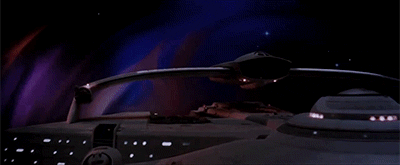Been watching DS9 and as amazing as they are…Trek’s space battle scenes don’t make a whit of sense.
The writers have two-dimensional thinking. So, we have to get past an enemy fleet. The fleets are always gathered horizontally. Well, how about simply flying upward or downward?
Am I missing something?
Mostly, no.
But there's some wiggle room there. Sensors are amazing in Trek, so if you try to fly above the enemy fleet, the enemy fleet can see that very quickly and rise to your level, unless you're extremely maneuverable such that no enemy ship can keep up with you. But even then, they can still shoot at you anyway.
The really iffy part is that these massive fleets just *have* to meet each other at all in the first place. In three dimensional space, a fleet should be able to fly in a totally unexpected direction and approach their target from the completely opposite end of where the enemy fleet is waiting for them. I guess that part's still partially covered by sensors being amazing and partially by defensive fleets just waiting right on top of the target.









